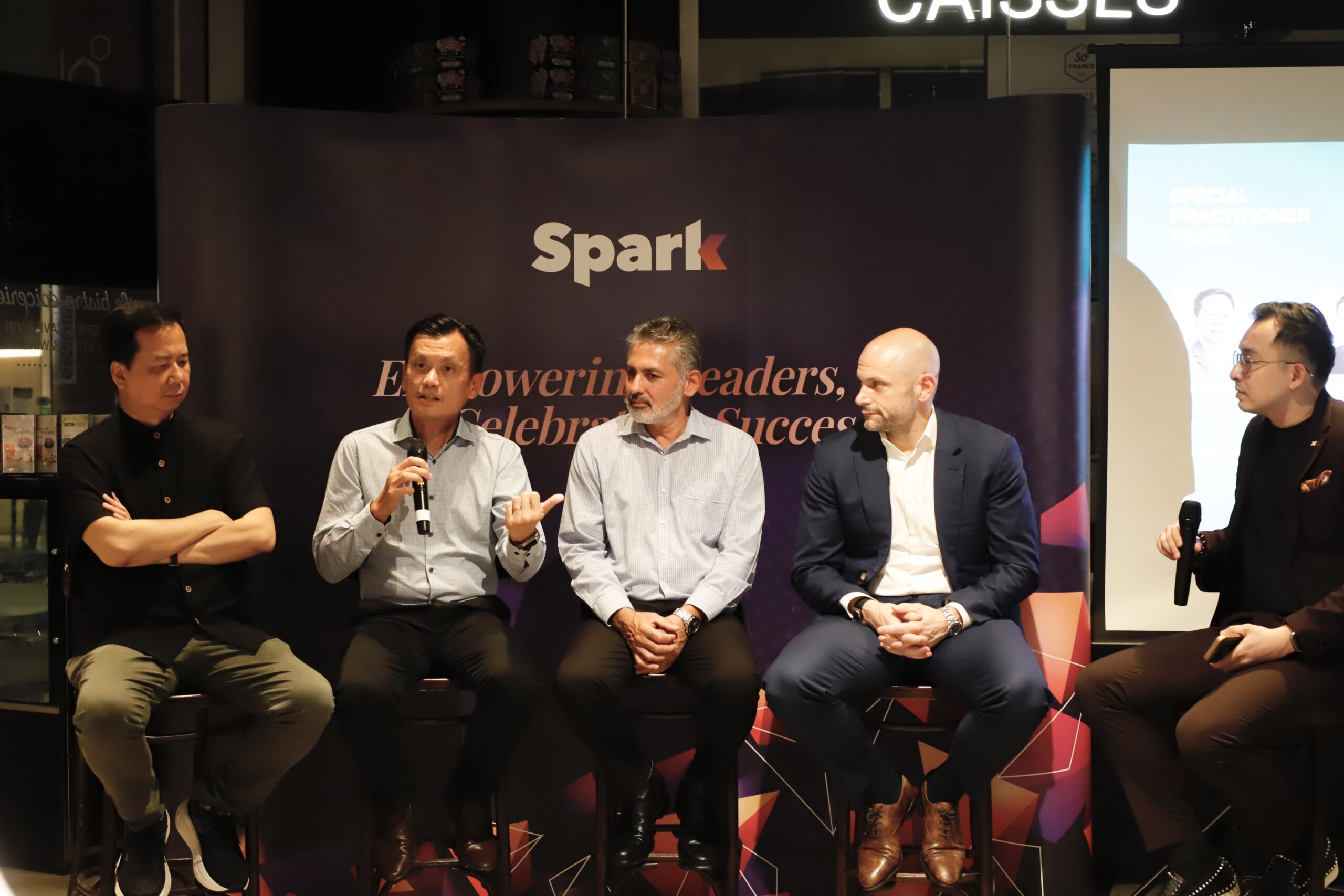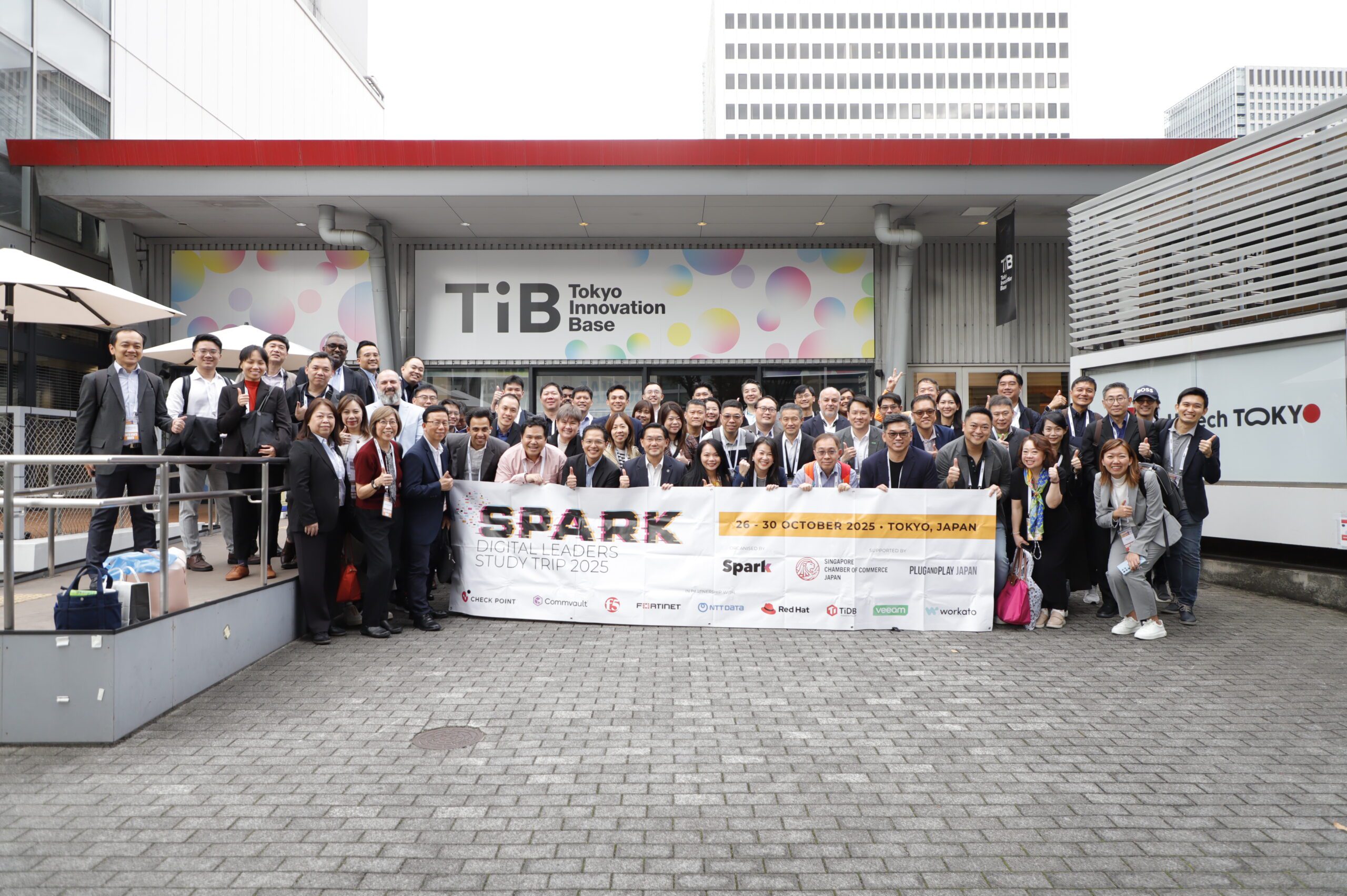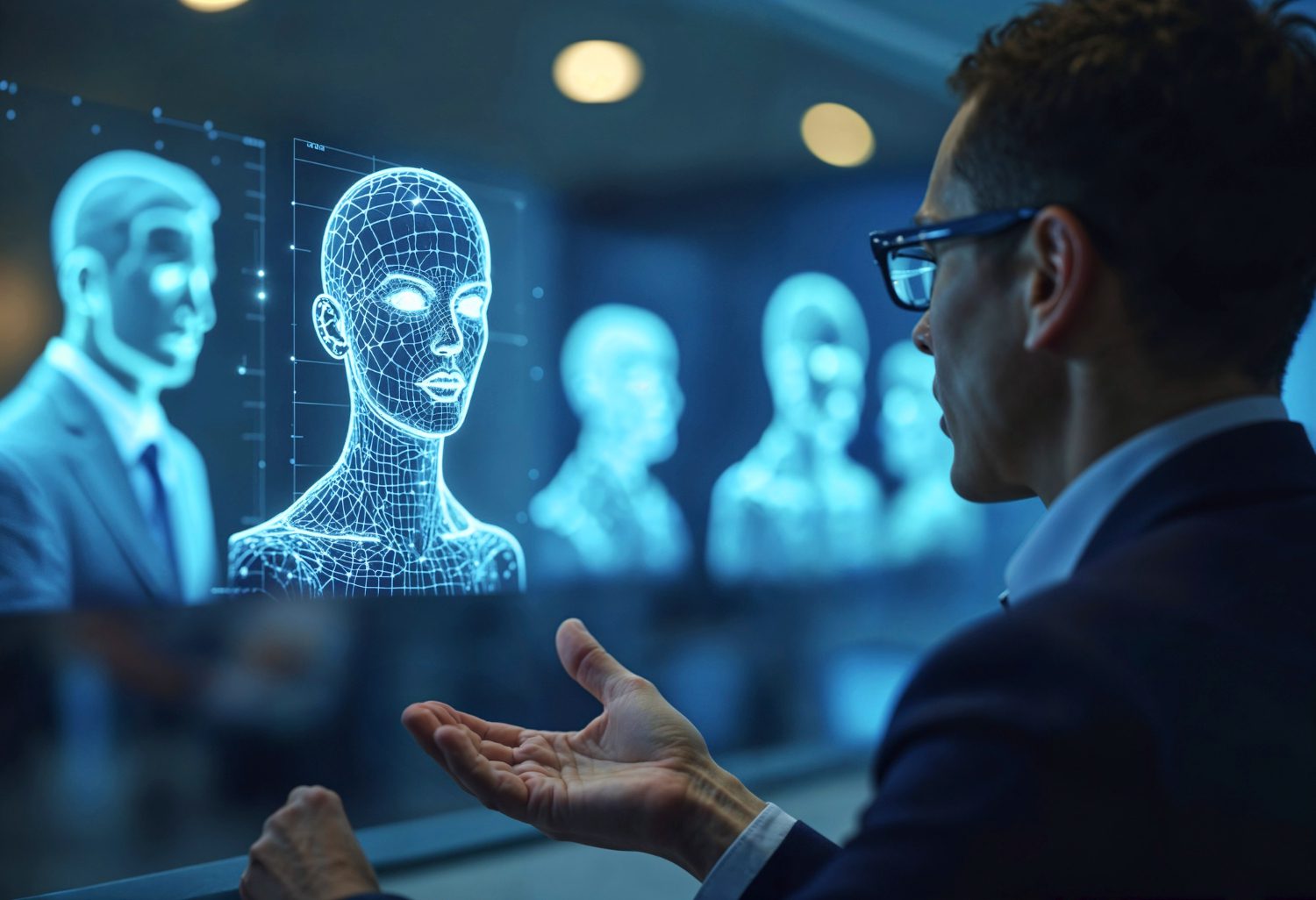[vc_row][vc_column][vc_column_text]CIO reThink Forum is an exclusive event organised by CIO Academy Asia (CIOAA) together with our partners CIO VN, VACD and Luxcer that brings together tech leaders from the public and private sectors, and technology companies to discuss how the tidal waves of new technologies have changed and are still changing the business environment; and how they need to ride these seismic changes in order for their businesses to thrive or minimally stay above these currents. The Forum “CIO reThink: Charting a New Course – Rethinking Your Strategies for the Digital Economy” was held at Sheraton Saigon Hotel & Towers, Ho Chí Minh City, on 15 May. The Forum saw highly engaged interactions — not only were the participants interested to hear more about the imperatives and challenges of digital transformation from the distinguished speakers and panelists, they were also open to share their own war stories and the challenges they encounter back in their companies.
Digital Transformation: Perspectives, Challenges and Learnings
Kicking off the CIO ReThink: Vietnam conference, the CEO of CIOAA P. Ramakrishna (Rama) placed the context to the existing business environment – that we are competing in a VUCA (volatile, uncertain, complex, and ambiguous) world, a term borrowed from the US military to describe the dangers that await the armed forces after the Cold War. From terrorism to climate change to cyber attacks, ”everytime you turn on the news there is something (unsettling) happening. The same word VUCA can be used to describe the (business) situation we are living in today,” he said.
Rama also laid out the major drivers affecting the business world and their attendant concerns, precipitated by the tsunami of technological advances. For example, people are concerned if technology will replace their jobs. These concerns are not unfounded and the expressions of concerns and distress will continue to resonate louder as “we are only at the beginning of the fourth industrial revolution”, which encompasses radical shifts in the physical, digital and biological spaces.
Rama cautioned that we could expect more changes as these new emerging technologies mature which would have disruptive consequences for both governments and businesses. He cited the examples of new business models in the case of online platform companies (e.g., Grab, Airbnb) which have totally disrupted the transport and hospitality sectors.
Similarly, organisational culture has been changing rapidly, he said. With several generations working alongside each other, aided by new technologies such as mobility and Augmented Reality (AR), the way of working today is different from past eras. One upshot of it is the rise of culture issues and integration challenges that business leaders have to deal with.
There was a time when superpower meant a powerful country or countries. Today, it means technology. The ABCD (AI, Blockchain, Cloud, Data Analysis) technologies are the new superpowers, Rama commented.
“If you are a CIO, you are expected to change the game,” Rama remarked. Merely keeping the lights on is no longer enough. You need to do the Fosbury Flop– a style used in the athletics event of high jump, popularised and perfected by American athlete Dick Fosbury (whose gold medal in the 1968 Summer Olympics grabbed the world’s attention to this high jump technique). CIOs today are expected to take quantum leaps in efficiencies, manage customer expectations (who want products or services personalised, fast, and made available through omni-channel platforms), he emphasised.
Underpinning Digital Transformation (DX) in the context of People, Technology and Process, Rama outlined that in businesses today, there is a concern about people and culture in organisations. One, to build an innovative culture, businesses needs to hire the people with the right skills. Two, there is a whole suite of C-suite executives and they must be in harmony with each other to deliver impact to the business.
Equally important is the issue of change management, Rama continued. How do you manage disruption as customers as well as employees want processes or products and services rolled out faster and with agility?
Contextualising the Rethink conference, Rama urged the CIOs to challenge the traditional way of working. “We want leaders like you to rethink to go about doing your work,” he said. “There will be tension, a tug of war (between resources and requirements). How do you make digital transformation sustainable in your organisations?”
Finally, he closed his remarks by sharing the CIOAA survey conducted in ASEAN, which sought to explore what was going to bear the biggest impact on businesses in the next two years. The results showed that data analytics and AI, cloud, and IoT were all top of the mind issues for CIOs. But when asked where they would be spending more money, cyber security emerged as the number one issue. This was largely due to their concerns about internal threats, compliance, and security policy across the organisation.
He also mentioned that according to the survey, challenges to digital transformation consisted of internal processes, resources, and infrastructure. These were the top 3 concerns of CIOs in the region.
Reaching your destination in the new digital roadmap
In his keynote address, Dao Thanh Tu, CIO, Prudential Vietnam Assurance, shared that technology companies are coming up with new technologies which are having an impact on the business and processes of other companies globally.
Looking at the imperatives of Digital Transformation through the prism of people, process, technology, he emphasized that among the three, people are the key. It is at the level of people that we have to change the mindset so that digital transformation could be implemented, he suggested. Once the mindset is changed, only then they will be able to move the company forward with speed through digital transformation.
[/vc_column_text][/vc_column][/vc_row][vc_row][vc_column][vc_cta h2=”Key Takeaways” color=”turquoise” el_width=”lg”]
- Gen X and Gen Y are working together and they have different views and expectations.
- Automation, processes, self-service, workflows–these are some of the key concerns of businesses in Vietnam in the context of digital transformation
- Multi-cloud options or self-service cloud options are available to businesses in Vietnam but it is the legacy systems that are holding the transformation process back.
- Agility and speed are of essence for digital transformation to be effective in the changing ecosystem; if we are slow, we will fail soon for sure.
[/vc_cta][/vc_column][/vc_row][vc_row][vc_column][vc_column_text]
Accelerating Digital Transformation with the enterprise cloud platform
The fast fish can eat the slow fish, and in the era of Digital Transformation, organisations have to be fast to adopt new technologies to compete in the rapidly changing ecosystem.
In his presentation, Hung Nguyen, Country Sales Director, Nutanix Vietnam, shared his thoughts and experiences about how companies could accelerate digital transformation with enterprise cloud platforms.
Since cloud is one of the ABCD superpower technologies, he looked at ways that cloud technology could be deployed to help companies transform digitally.
The starting point of digital transformation is choosing between public or private cloud. The good news is that today, a customer has multiple choice of clouds. With Nutanix, they can switch from one type of cloud to another.[/vc_column_text][vc_cta h2=”Key Takeaways” color=”turquoise” el_width=”lg”]
- Cloud could be set it up in minutes; it requires less capital investment, offers expansion capacity.
- Cloud cuts down on your need for IT staff. You can manage the whole infrastructure with one or two people, instead of having separate teams for different IT operations.
[/vc_cta][vc_column_text]
Panel discussion: Building an effective digital ecosystem for the 4th Industrial Revolution
This panel discussion explored how open innovation and partnerships (with customers, with business allies, with competitors, with startups) allow firms to win in the digital economy. Panelists included Phí Anh Tuan– Chairman & CIO, PAT Consulting Ltd, Trần Công Quỳnh Lân– Deputy General Director, VietinBank, Gordon Heap, General Manager, DXC Technology, and Hung Nguyen, Country Sales Director, Nutanix Vietnam.
Moderating the discussion, Rama, CEO, CIO Academy Asia, asked Gordon Heap what mattered most when building an effective ecosystem.
Heap argued that since digital does not respect any boundaries, countries or industries, organisations needed to collaborate to succeed. “We don’t have the expertise and skill sets to pull everything off,” he said. For example, take the number of data scientists, he said. “We don’t have enough (data scientists). We need to get more Vietnamese together in technology and strategy.”
According to Phí Anh Tuan, technology offers a big opportunity to businesses, as it can bring more efficiency to organisations. For example, at the Vietnamese ports, cameras empowered by artificial intelligence (AI) can help reduce the number of workforce, while amping up the checking process.
As far as digital transformation in Vietnam is concerned, some sectors are adopting technology faster than others. For instance, the insurance sector is slower than the Fast Moving Consumer Goods (FMCG) sector. However, the insurance sector is changing too. Earlier, there were different systems in different countries, but digital has changed that.
Hung Nguyen offered an example from the healthcare sector. Earlier, patients had to wait for days to check their medical records or test results. Now, they can see their records instantly through the cloud.[/vc_column_text][vc_cta h2=”Key Takeaways” color=”turquoise” el_width=”lg”]
- On-prem is too slow; we need speed. Think of strategy differently. Deliver incremental value quickly
- Many people talk about transformation, but it does not get done thoroughly. There is still a mix of manual and automation.
- Those who are encumbered with legacy systems (such as governments), will be slow to transform digitally.
- Having a master plan for digital transformation is good but if you don’t execute it, it will never work.
- Digital leadership must come from the top.
- Technology is an enabler; end of the day, it has to bring benefits to the business.
[/vc_cta][vc_column_text]
Operationalising the Modern Day Digital Economy to Reshape the Customer Experience
There is much hype around digital transformation and it is critical for us to understand our customer before we embark on a journey of digital transformation, said Gordon Heap, General Manager, DXC Technology, in this seminal keynote.
He offered many examples of startups and companies such as Uber and Airbnb and Apple, that have the customer at the centre of their digital journey. For instance, in the case of Uber and Airbnb – their initial focus was to find the customer. Only then they tried to find the right technology to scale up.
Similarly, smart tennis racquet manufacturer Babolat introduced data gathering technology in its racquets to help players enhance their game. And bucking the trend, Apple opened a brick and mortar store in 2001 to serve its customers. Apple does an excellent job of blending technology and human touch, Heap said.
Last year, more than 50% of the world got connected to the internet, and there are more than 3 billion smartphones acquired globally in the market. The smartphone is enabling the creation of disruptive business models. According to The Economist, 866 million people operate with mobile money now and have no relationship with a bank.[/vc_column_text][vc_cta h2=”Key Takeaways” color=”turquoise” el_width=”lg”]
- Enhancing customer experience is one of the number one reasons for investing in digital transformation.
- Digital strategy can be employed to improve customer experience and raise revenues.
- Customer experience is no longer the domain of CMOs. Many in the C-suite are now contributing to enhancing the customer experience.
- The fundamentals of the digital revolution are overshadowed by the emergence of digital technologies like Blockchain, robotics, etc; a myriad of technologies are available to us today but we should consider them only as a framework to enable our business transformation–we can pick and choose which ones are more relevant to our business needs.
[/vc_cta][vc_column_text]
Managing Risk in the Digital World
In this comprehensive keynote, JP Yu, Regional Director, RSA APJ, started off by asking what constituted the top risks of doing business today. The answer was cyber attacks which ranks as one of the highest business risks globally.
Be it banking or healthcare, all business sectors have embarked on their digital transformation journeys and all of them face the specter of cyber attacks. On top of that, regulation changes very fast in the region. On any given day, there are at least 50 new regulation changes in APAC.
How do we respond to such challenges? Yu suggested that if we keep doing it in a siloed approach, there will be cracks; we need to look with a combined approach at digital risk.
Digital risk management accompanies digital transformation, Yu concluded. Organisations need to assess and treat the risks (Data resiliency and data protection/privacy/GDPR) arising out in the process–these risks are unexpected aspects of the digital transformation process.[/vc_column_text][vc_cta h2=”Key Takeaways” color=”turquoise” el_width=”lg”]
- Earlier, the push was to drive a company’s profits; now, the focus is on how do we drive innovation without compromising on data and survive the data breach, ensure compliance and ensure resiliency.
- Security has to be across the board since all solution areas are inter-connected.
- Create visibility across the infrastructure; drive insights from seemingly unrelated events, so that we can take steps to mitigate cyber attacks.
[/vc_cta][vc_column_text]
Panel discussion: In a dangerous world, what are the guardrails to protect our digital journey?
It is extremely risky for businesses to operate in the current environment of data breaches and hacking incidents. According to one cybersecurity report on the Vietnam cybersecurity landscape, said Low Aik Lim – Director of International Relations, CIO Academy Asia, the moderator of this panel discussion, the damage caused by computer viruses to end users in Vietnam reached a record of VND 14.9 billion (or about USD 642 million), a rise of 21% compared to 2017. The report went on to share that more than 60% of agencies and enterprises in Vietnam are infected with cryptomining malware.
This panel discussion looked at how organisations can defend the integrity and resilience of their digital infrastructure. The panel consisted of Vũ Thái Hà, Founder & Director, Life+, Masud Parvez John, CIO, Hoan My Medical Corporation, JP Yu, Regional Director, RSA APJ, RSA, a Dell Technologies Business, and Magda Chelly, Managing Director, Responsible Cyber.
According to Ha, in recent years, user data leakage, virus and ransomware have been very popular in the Vietnamese media. They have been widely reported on. However, there are more riskier things than virus, etc., that people are still not fully aware of, including risks from people inside organisations.
In terms of awareness about security, as data from the Vietnam Security Association suggests, the security software market growth has been on the upswing. “There are many players in the market now and awareness about security has been growing in the last 15 years, and now we are focusing on risk much more than ever,” he said.
John, the CIO of a large healthcare organisation in Vietnam, which serves 4 million patients in a year, remarked that IT is already an outdated term. Now it is time for DT –digitalised technology, that empowers others. But the flip side is that when you empower others, you open up yourselves to risks. There were a lot of lessons learnt in the process.
He brought up instances from various hacks and data breaches that are cautionary tales for companies: Telecom giant Singtel exposed 10,000 access points of its customers; SingHealth saw 1.4 million of its patient records hacked out, and the loss was realised only after a week; Toyota Motors saw more than a million customer information leak last year (but apparently no credit card information was leaked).
In the context of such large-scale breaches, Magda said that there is a lack of understanding about what cyber security actually means. It is not just about technology. No matter how sophisticated tools you have, you can still be a victim of an attack. 340,000 new malware are churned out per day – how do you fight it? Our systems can’t detect these malicious programmes, she said.
She highlighted the three pillars of security: people, process and technology. “Education is the most important part of cyber security,” she concluded. Organising one phishing simulation exercise per year for your employees, for example, won’t help . Either you put in place an overall cyber management programme or you waste your money, she said. “You need to have a continuous and rigorous cyber education programme to build awareness in your organisation,” she said.[/vc_column_text][vc_cta h2=”Key Takeaways” color=”turquoise” el_width=”lg”]
- Normally people don’t have an understanding of cyber awareness. You have to
- understand what tools they are using and they are the main entry points of malicious risk.
- There is a perception about hackers which is not right. Anyone could be a hacker. Have the right process to avoid “social engineering” attacks
- Cyber security is like going to the gym. You don’t see results in one day. It takes time. Collaboration is important for the ecosystem. Assess the security posture of third party companies you work with.
- Apply the zero trust model. People inside your organisation could be creating risks. Security is a trade off. You have to swing between trust and no trust.
[/vc_cta][vc_column_text]
Industry’s best practices for corporations – from a Hacker’s perspectives
This was one of the most fascinating sessions of the conference. Magda Chelly, Managing Director, Responsible Cyber, and a well-known cyber feminist hacker who wants to bring more women in the cyber-security field, shared her insights with the audience about hackers and hacking.
“We see only 5% of the internet–95% of the web is deep or dark web,” she said. “Attacks could be made using malware bought off the dark web.”
According to her, Google is your best hacking tool. It is used to learn about the victim.
Hackers find leaked databases on the web that they use to organise attacks. In the past, Yahoo and Adobe have been hacked. All those databases are now available on dark web or even google (Search for leaked databases on Github).
She highlighted a new breed of hackers who are different from the traditional hackers. These are social engineer hackers.
A social engineer will manipulate humans to part with information. For example, he or she will send an email from the company’s CEO to release a payment within 15 minutes. An unsuspecting staff member could easily fall prey to such tricks if he or she is not aware.
Finally, she concluded that security could be strengthened through the right people, process, and technology strategy in place. However, there is never a 100% security for your company. “You make it harder for cyber criminals to enter your house but they might still find some other way to break into your house (cyber attack),” she added.[/vc_column_text][vc_cta h2=”Key Takeaways” color=”turquoise” el_width=”lg”]
- The most effective way to mitigate cyber attack is you need to know what your data is, what is valuable to you? That’s the first step. Second, you have to know where is your data. It’s on the cloud but exactly where? You have to have visibility.
- Understand your risks and put controls in place. When vendors come to you, ask the right questions. Challenge them and you will make a lot of savings.
- Don’t assume that your development team is security savvy; also, your IT guy may not be from security background. These assumptions are two common mistakes
- Passwords are common ways to get hacked–they can be hacked in 8 seconds
- 100% security is not possible. Will your firewall protect you? Firewall bypass can be used to do the damage.
- Most companies don’t have the security framework for integrating IoT devices/web applications into their systems. Don’t connect directly to third party systems.
[/vc_cta][vc_column_text]
Digital Transformation – Small Step Execution to a Successful Strategy
In this keynote, Nguyen Chi Duc, Director, Votiva, threw light on how digital transformation could be executed by taking small steps.
He pointed out how customers are very demanding now. They want goods and services at cheapest prices, with fastest delivery timelines. This is especially so in the consumer business.
Why is this so? Because “today the customer has much more power in the market,” he said. “He has the power to influence back the manufacturer.”
Therefore, according to Duc, the key to a successful digital transformation strategy is customer focus. A business will have to keep transforming itself so that the customer remains engaged for the long run. He cited the examples of hotels; how they had to change the way their engaged their customers after Airbnb came into the scene. Similarly, after Uber ventured into the market, taxi companies had to change their operations because of competition.[/vc_column_text][vc_cta h2=”Key Takeaways” color=”turquoise” el_width=”lg”]
- Digital transformation is not about technology. It’s a matter of strategy and thinking. Technology is a tool to transform the business
- Engage customer for business transformation (as Satya Nadella advised)
- Learn fast, fail fast, and use the learning for the next iteration of Digital transformation
- Leadership has to be involved in the Digital transformation project. If they are not, there is 60-70 percent chance of failure.
[/vc_cta][vc_column_text]
Workforce Mobility Transformation
In this keynote, Giap Nguyen, Country General Manager, Lenovo, touched on the topic of today’s workforce and how they can contribute well to the digital transformation journey of a company through mobile technologies.
According to Nguyen, today there exists a complex IT environment especially for multinational organisations. This requires mobility in terms of demographics, Gen X and Y.
From a technology perspective, different people in the same organisation have different devices, and it becomes a challenge to support them. However, Lenovo has many solutions to cater to the different needs of different set of employees, whether in office or out in the field.
Digital Transformation- A Practitioner’s Guide for Successful Outcomes
Having the digital transformation agenda is one thing and implementing it for successful outcomes is another ball game. Lui Sieh – Principal Consultant, CIO Advisory, SynergySynq, shared his learnings and approaches on this topic during his keynote.
According to Sieh, Digital transformation is about future proofing. We have seen 100 year old companies and 10 year old startups dying every year. “We don’t know who will go out of business next,” he said.
The question to ponder on in this background is: how do we eliminate the non-essentials? What is the core of our business and how do we strengthen it?
He cited the example of Starbucks. Is it coffee company? Is it a bank? Is it into real estate Starbucks is holding on to $2 billion of its customers’ money in its loyalty cards. Similarly, Amazon started off with selling books, but its vision is to be the world’s biggest marketplace.
They key to successful outcome is to have a business strategy, a data strategy and a people strategy (succession etc. as high level leaders keep moving within an organisation).[/vc_column_text][vc_cta h2=”Key Takeaways” color=”turquoise” el_width=”lg”]
- You have to be people-ready and communicate the vision to your employees, to the people at the bottom.
- How do you want to talk about new business? You have to find a new language for your 21st century business.
- For Corporate IT and Operational IT (IoT), you have to worry about security and data management.
[/vc_cta][vc_column_text]
reThink: Leapfrog through Digital Transformation
In this concluding panel discussion, practitioners from various industries discussed to figure out ways and methods to deal with the current drivers of the Fourth Industrial Revolution (4IR) such as cloud computing and artificial intelligence. The panelists included Lui Sieh – Principal Consultant, CIO Advisory, SynergySynq, Đinh Quang Nương – Deputy CEO & CIO, Nguyen Hoang Group, Rahul Shinde – CIO, Cola Beverages Vietnam, and Genady Chybranov – CTO, Financial Services APAC, Hitachi Vantara. The discussion was moderated by Koh Kok Tian (KT) – Deputy CEO, CIO Academy Asia.
The discussion ranged from mass customization trends, need for new kind of education and workforce training and talent management issues.
Rahul Shinde shared his insights from one of the FMCG giants, Coca-Cola. According to him, this MNC’s business strategy is to make Coca-Cola available within clicks and across channels (so both online and offline; Only brick mortar is not enough). The second part of the strategy is to increase portfolio of products especially healthy products.
From digital transformation point of view, the company’s strategy is around three pillars broadly: digitise consumers, digitise customers & digitise internally.
Coming to personalisation, he said that customers want products from the channel of their own choice, and they want it customised. That’s why the company is offering more personalised products, leveraging on local experience based on buying pattern of customers. Such product offerings could be seen in Japan and Vietnam for example.
Other panelists pointed out how banks, for instance, differentiated from each other, and how customer data played a key role in deriving customer insights.
One panelist highlighted how cashless, mobile banking is on the rise across countries and what kind of impact it will have on retail banking workforce.
The panelists made one of the most significant observations regarding education and training–that teaching is stuck in the old ways whereas the world has moved on.
For digital transformation to succeed, getting the right talent at the right time is critical. When Kok Tian asked the panelists how best to manage talents in the digital economy, a bunch of thoughts were shared, that emphasized aspects of diversity of gender and educational backgrounds, and applying the apprenticeship model to talent development.[/vc_column_text][vc_cta h2=”Key Takeaways” color=”turquoise” el_width=”lg”]
- Take incremental steps; experiment; be agile; that’s how you can achieve balance between growth and security in your digital transformation journey
- Digital transformation is a journey; it is not an IT journey alone, rather everyone in the organisation is involved.
- Mass customisation is a new trend.
- IT is learnt through apprenticeship. No amount of certification can make you an expert.
- Use the apprenticeship model. Bring the youngsters in. Develop a pipeline.
- Preparing the workforce for the 21st century should involve people regardless of their background.
- The role of HR in any organisation is more important for Digital transformation as the centrepoint of this transformation is people.
[/vc_cta][vc_column_text]
Roundtable Topical discussions
The last activity of the conference was roundtable topical discussions where different aspects of digital transformation were discussed.[/vc_column_text][vc_cta h2=”Key Takeaways” color=”turquoise” el_width=”lg”]
- The DX process is a data driven one and leverages on the advantages provided by the cloud; the challenge is moving the data to the cloud while maintaining the privacy and security of the data.
- An organisation has two big struggles in the DX journey: do you worry about customer experience or your internal processes? What are your priorities and how are you going to use your resources? There was agreement among participants that the customer experience is of utmost importance.
- The two critical success factors for DX to be fully realised are: thinking beyond the box (innovation), and agility (fast execution).
- There was wide agreement amongst the participants that the fundamentals of people, process and technology are the mainstays for DX to be effective. In addition, alignment (between business and IT), culture and change are important too for it to work in any organisation.
- Engaging third parties in DX with fixed outcomes in mind or on a fixed price model could be a challenge. For DX to be effective, there has to be a flexible model. For example, innovative organisations and governments (such as the Singapore government) are adopting new procurement models where the focus is more on problem-solving than on delivering a pre-conceived and agreed upon solution. So, organisations need to move away from traditional models of procurement and share the risk with third parties in their quest to co-create (solutions).
- Risk management is everybody’s responsibility and every person in the organisation has to play a role in mitigating risks. For example, in Coca Cola, security scans are done before third parties or vendors are onboarded.
[/vc_cta][vc_column_text]In today’s VUCA scenario, staying in one place and not doing anything is no longer an option. Rama rounded up the discussions with the message that either you innovate or you die–that is the mandate the CIOs and tech leaders have to operate in. The mantra today is that the fast ones will defeat the slow ones. To take on the challenge of DX, we also learnt today that we have to think of new business models, new procurement models, think out of the box and set up the right ecosystem to make DX a success.[/vc_column_text][/vc_column][/vc_row]







